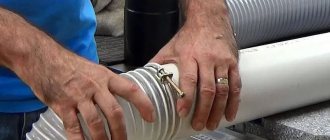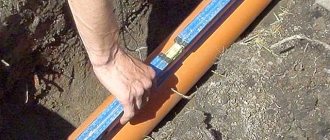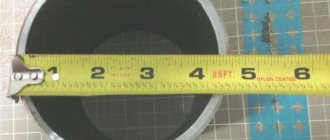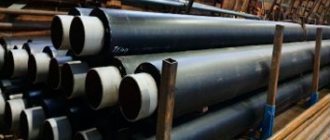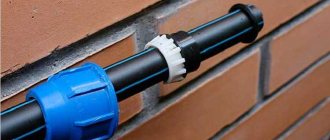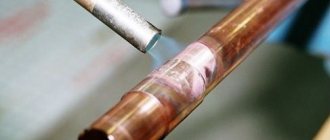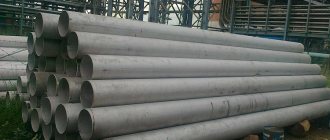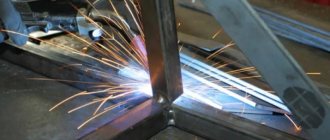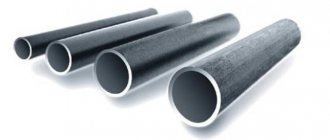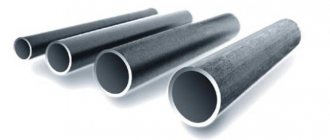A pipe with a socket is used to connect pipelines to each other.
Connecting pipes using a socket.
The meaning of the device is that the surfaces to be connected are made of a conical shape and are provided with an adhesive layer, and the split retaining ring is combined with the conical part of the socket. A socket connection of pipes is used when installing corrosion-resistant pipelines made of plastic, metal (steel, cast iron, etc.) and fiberglass materials.
Sealing sockets with cement mortar
To connect different parts of the sewer system using shaped elements, it is necessary to somehow fill the free space between the inserted pipe and the internal cavity of the socket. For a high-quality and reliable connection, the elements to be connected must be cleaned.
To seal, a resin rope in the form of a ring is wound in front of the socket, and this structure is pushed into the socket of the sewer pipe. It is important to ensure that the end of the strand does not end up inside the structure itself, so it needs to be draped over the top of the ring. As a result, the strand should occupy two-thirds of the free space between the pipes. Sealant for sewer pipes is also used, which is quite effective and reliable.
When the strand is in place, a cement solution is prepared. It covers the entire remaining space, for which you can use a scoop. After caulking, the solution is compacted and the sockets of the sewer pipes are caulked until the solution is completely compacted. The cement mortar is made in a ratio of 9:1 (cement and water, respectively).
To ensure that the mixture sets well, the joint is covered with a wet cloth after processing. In hot weather, it is advisable to periodically spray this rag with water. In winter, heating of pipes must be added to the list of works, and the solution is made on the basis of warm water. The joints of sewer pipes should be insulated upon completion of work.
When to use a sealant
An additional seal for socket joints of cast iron pipes is used in two cases:
- for additional sealing during installation;
- to eliminate leaks that arise during operation.
As a result of a violation of the tightness and integrity of the coinage, leaks form at the pipe joints.
The additional seal is considered more reliable than embossing. It is suitable for sewer and water supply networks. Consists of unlockable cast iron rings, rubber gasket and long bolts with nuts.
Troubleshooting is carried out without reducing the pressure in the line in any weather.
Sealing a sewer pipe joint with expanding cement
Processing the socket with a resin rope and cement is a rather labor-intensive process that takes a lot of time, effort and material. In addition, the joining of sewer pipes will greatly depend on how tightly the material is laid in the socket. Expanding cement can be used to provide a more secure connection between the socket and the pipe. This cement is waterproof and, when hardened, can completely fill the space available to it. When using this material, you can significantly save time and effort, since in this case you can do without embossing. Sealing joints with expanding cement is done as follows:
- first, you need to wind several white strands in front of the bell;
- then they are pushed into the socket using a thin object;
- Now the structure needs to be centered, for which you need to take three wedges and do the following: the wedges are driven into the socket so that the pipe is in the center of the resulting ring;
- the free space is filled with cement made in a ratio of 10:7 (cement and water, respectively).
Conclusions and useful video on the topic
The author talks about the nuances and problems that arise when joining pipes during sewer installation:
The author of this video shares how to solve his problem:
Connecting pipes correctly is very important. The joint has always been the weakest point of the pipeline. If it is performed incorrectly, then, as a result, leaks, blockages, and sometimes pipe ruptures will certainly occur. Therefore, before you begin installing plumbing communications yourself, you need to study all existing connection methods. If the matter seems complicated, you can always turn to professionals.
Plastic pipe standards
Plastic pipes for sewerage have a length of 3, 6, 10, 12 meters and a diameter of 40, 50, 85 and 100 millimeters. When choosing plastic pipes, you need to pay attention to their quality: the presence of bubbles, swellings, various foreign elements and an uneven surface - any of these signs indicate that such a pipe should be avoided (for more details: “Plastic pipes for sewerage - types and sizes "). The ends of the pipes must be cut evenly and cleaned of roughness. To connect the socket of a plastic sewer pipe, welding or special glue is used (pro
Assortment of concrete products. Manufacturing Features
Concrete socket pipes are used in civil and industrial construction. They are inexpensive, practical, and durable in use. Most often they are used in the construction of sewerage systems, urban stormwater systems, and water bypass pipelines in road construction. According to their purpose, reinforced concrete products are divided into:
- non-pressure;
- pressure;
- designed for all types of road construction.
Socket pipes made of concrete are of pressure and non-pressure types
The industry produces three main types of socket pipes: type T, type TB and type TV. They differ in the production method, load characteristics, and other special parameters provided for by GOSTs.
Reinforced concrete free-flow pipes of type T are used for laying sewer systems, surface and groundwater drainage systems, and other liquids that are non-aggressive to this product. They can withstand significant loads, are inexpensive in manufacturing costs, and contain readily available materials.
The TB type is capable of bearing an increased load during operation. They can be supplied with rubber O-rings, which make the connections easier to install, making them leak-tight.
Important! Such pipelines can be used as pressure pipelines for pumping water and other liquids that are neutral to the concrete composition.
For example: the most used pipe dimensions are socketed products with a length of 5 m, a diameter of 1 m and a wall thickness of 75 mm. They are optimal from the point of view of the design of the sewer collector, and make up a convenient load for transportation by car - 5 pieces each on a specialized platform.
TV type pipes are intended for use in road construction. These are especially durable products, equipped with sealing rings, capable of withstanding the pressure of soil layers and the work of the road flooring for a long time. They are divided into four groups according to their load-bearing characteristics:
- Group 1 – ability to bear the pressure of backfill soil and road surface up to 5 meters thick;
- Group 2 – load capacity up to 10 meters;
- Group 3 – load capacity up to 15 meters;
- Group 4 – up to 20 meters of backfill thickness.
A socketed concrete sewer pipe is a rigid and reliable structure whose service life exceeds 50 years. What makes it this way is the special technology of using durable concrete, special structural reinforcement and high-tech manufacturing methods. The price-quality ratio of this design is optimal, which is why most design and construction organizations, when searching for the necessary pipes for organizing the construction of hydraulic systems, opt for concrete products.
Concrete pipes with and without sockets are most often used in drainage and sewer systems
Methods for connecting sockets
The most common method of connecting plastic parts to each other is a socket connection with a rubber ring. To implement such a connection, you need to take the following steps:
- first, the cleaned rubber ring is placed in the socket of the sewer pipe;
- the end of the pipe must be lubricated with glycerin or soap to facilitate the connection;
- the coated part of the pipe is inserted into the socket of the sewer pipe to the marked point;
- When the connection is established, the loose part must be turned slightly to check whether the ring is in place.
There are other methods for installing connections between sewer system elements:
- To properly connect a ceramic toilet bowl and a plastic pipeline, it is necessary to use seals, and the remaining gap is filled with cement mortar.
- Plastic siphons are connected to the sewer system using special rubber adapters inserted into the socket of the sewer pipe.
- Cast iron pipes are connected to a plastic riser through a polyethylene adapter equipped with a special socket with a groove, which allows for the most reliable connection.
Where are socket structures used?
Pipelines, the elements of which are joined using expansion funnels, are most often used to transport process water and sewage through internal and external networks.
Their installation requires minimal costs, and the method is simple. Therefore, such structures are important in servicing industrial and civil construction projects:
- residential buildings and industrial buildings,
- hydraulic structures.
In addition, socket joints are used in agriculture and to protect electrical cables from damage. There are several types of such products.
Connecting pipes with glue
This connection involves the use of glue to join the parts. First, it is necessary to prepare the elements to be glued, for which the structure is thoroughly sanded and degreased. After this, the glue is prepared. There are two main options for gluing plastic parts:
- Adhesive made in a ratio of 15:85 (perchlorovinyl resin, methylene chloride);
- Glue made in a ratio of 15:75:10 (perchlorovinyl resin, methylene chloride, cyclohexanone).
The second composition is suitable for gluing large diameter pipes at temperatures above 20 degrees. This glue becomes unusable very quickly: four hours in the open air is enough for it to evaporate. Because of this, it must be used very quickly or stored in an airtight container. To glue the joint, you need to apply glue to a third of the depth of the socket, and the rest is spread in a small layer on the section of the pipe that will enter the socket of the sewer pipe. The glue needs at least 2 hours to harden.
Some details about socket weld fittings
Socket weld fittings are a type of high pressure fittings used in various industrial processes.
They are used for lines transporting flammable, toxic or high-value materials where leakage is not permitted, and for steam from 300 to 600 psi
They are only used in combination with ASME pipes and are available in the same size range.
They are used in areas where piping work is permanent and are designed to provide good flow characteristics.
They are manufactured to several ASTM standards and manufactured to ASME B16.11. Standard B16.11 covers pressure-temperature ratings, dimensions, tolerances, markings, and material requirements for forged carbon and alloy steel. Acceptable material forms are forgings, rods, seamless pipes that meet the fitting chemical requirements, melting methods, and mechanical property requirements of ASTM A105, A182, or A350.
They are available in three pressure ratings: 3000, 6000 and 9000 class.
Dismantling the old system
Often, problems can be caused not by the installation of sewer pipes, but by their dismantling, so this stage of repair also needs to be thought through. First of all, you should free up your workspace by removing furniture, partitions, etc.
Having gained full access to the riser, you need to prepare the tool you will use for dismantling:
- Bulgarian;
- Needle file;
- Hammer;
- Hammer;
- Chisel;
- Various screwdrivers;
- A hacksaw for metal.
The dismantling itself should be done in the following order:
- When making repairs in an apartment building, be sure to warn your neighbors not to use the sewer system;
- Turn off the water;
- Disconnect the hose supplying water to the toilet flush tank;
- Remove the toilet by unscrewing the bolts from the floor;
- Disconnect other plumbing fixtures (bathtub, sink, etc.);
- Next, all that remains is to dismantle the old pipes.
It is worth examining in more detail the dismantling of cast iron pipes. Typically, such pipes are secured with socket fittings, so they can be easily removed using a hammer and chisel.
When you reach the fitting connecting the intra-apartment system to the common building riser, be careful: do not use a hammer, because you can damage the riser. You can remove the pipe from the common riser by stripping the seal.
Checking the system before use
The launch is carried out shortly after installation of the drainage pipeline elements; the PVC connection needs time to completely dry out and set, if an adhesive composition or sealant was used.
When using the detachable method or welding technology, control of the operation of the system according to the sewerage flow diagram is carried out immediately after installation. The pipeline is checked for leaks and bends as the temperature of the effluent increases. For this purpose, water is supplied - you need to turn the valve on the water riser. As the drains move, the condition of communications is monitored. For greater clarity, the pipe joints are covered with paper napkins, then you can notice the appearance of even a slight leak. To ensure that the pipeline is in a suitable condition for operation, you need to observe the movement of wastewater over a certain period of time.
Sequence of work
Installation of sewer pipes during sewerage installation is carried out in the following order:
Installation of a riser with terminations in the basement and on the roof
It is important to remember that the riser should be located near the plumbing. The connection in the basement is made with an inclined pipe leading into the septic tank
The end of the pipe in the attic should be equipped with a check valve or left open. Carrying out the supply from plumbing equipment to the central riser. Connecting the line to the riser from the rest of the plumbing located above the toilet entrance. Installation of siphons on each plumbing fixture. Connection of liner and siphons.
At this stage the work is considered completed. Next, it remains to check the tightness of the joints and the rigidity of the pipes on the walls, as well as the absence of discrepancies.
Advantages and disadvantages of socket weld fittings
Advantages
- The pipe should not be beveled to prepare the weld.
- Temporary fastening is not required for alignment because, in principle, the fitting ensures correct alignment.
- The weld metal cannot penetrate the pipe opening.
- They can be used in place of threaded fittings so there is much less risk of leakage.
- Radiography is not practical for fillet welds; therefore, proper installation and welding is critical. The fillet weld can be inspected by surface testing, magnetic particle (MP) or liquid-liquid (PT) methods.
- Installation costs are lower than with butt welds due to the lack of stringent assembly requirements and the lack of special processing to prepare end welds.
- Socket welding flange
- Pipe
- Socket welding elbow
- Fillet weld
- Clearance to compensate for thermal expansion
Flaws
- The welder must provide 1/16 inch (1.6 mm) clearance between the pipe and the flare collar. ASME B31.1 clause. 127.3 Preparation for Welding (E) Assembling a Socket Weld: When assembling a connection before welding, the pipe should be inserted into the socket to its maximum depth and then retracted approximately 1/16" (1.6 mm) from the contact between the end of the pipe and collar of the socket.
- Expansion gaps and internal gaps left in socket weld systems promote corrosion and make them less suitable for use in corrosive or radioactive environments where the accumulation of particulates in the joints can cause operational or maintenance problems. Generally, a butt weld joint is required for all pipe sizes with full penetration of the weld into the pipeline.
- Socket welding is not suitable for ultra high hydrostatic pressure (UHP) food processing applications as it does not provide full penetration and leaves overlaps and crevices that are very difficult to clean, creating virtual leaks.
The purpose of a gap at the bottom of the weld is usually to reduce residual stress at the weld root that may occur during solidification of the weld metal and to provide differential expansion of the mating members.
